| Pages:
1
..
62
63
64
65
66 |
symboom
International Hazard
    
Posts: 1143
Registered: 11-11-2010
Location: Wrongplanet
Member Is Offline
Mood: Doing science while it is still legal since 2010
|
|
I wish I knew russian tgere so much I miss just because the some videos are in another language
Great repurposing I would have thrown away my co2 canister
https://m.youtube.com/watch?v=5JdPQucTjjg
[Edited on 26-6-2017 by symboom]
|
|
|
NeonPulse
Hazard to Others
  
Posts: 417
Registered: 29-6-2013
Location: The other end of the internet.
Member Is Offline
Mood: Isolated from Reality! For Real this time....
|
|
So from what I can gather he heats KOH strongly to get rid of some water then adds Al powder and finally distilled off the K metal? I know it is
possible to make Cs metal via distillation with CsCl and Ca metal, do you think the same is possible to make K using KCl and Ca metal in a high temp
distillation? Has anyone tried this. I got the idea after watching a Cody's lab video where he attempted making K but only got NaK due to using sodium
metal in the prep. He tried with Mg metal but got no yield.
So maybe Ca metal will work. Any thoughts?
|
|
|
ave369
Eastern European Lady of Mad Science
   
Posts: 596
Registered: 8-7-2015
Location: No Location
Member Is Offline
Mood: No Mood
|
|
I know Russian and can translate the video. The author of the video blocked adding translated subtitles to his video, but I'll write the transcript
here.
0.00 - 0.11
Hello everyone, you are watching FireTV and today we'll make one of the most active metals, potassium. By the way, you can also make sodium this way,
the technology is exactly the same.
0.12 - 0.20
I've tried to make this metal at home many times, and at last I was successful. Let's start with the technology.
0.21 - 0.37
To make potassium, you need potassium hydroxide. To make sodium, you need sodium hydroxide, respectively. By the way, drain cleaner (referring to the
most common Russian brand, KROT) is essentially sodium hydroxide, and someday I'll try to make sodium from it. If you melt alkali and add aluminium to
it, we'll get aluminate, hydrogen gas and alkali metal we want.
0.38 - 1.07
If you heat the mixture well enough, the metal will start to evaporate, and ultimately condense in a colder spot. The schematic design of the
apparatus is very simple, it has an iron retort and a tube. But in reality, it is hard to make this work right. The mixture has to be heated to a very
high temperature, and the potassium or sodium vapors condense very fast, so the tube has to be short and quite wide. to ensure that the metal drops
flow down it easily.
1.08 - 1.47
Basically, you have a lot of conditions to meet. First, I tried these cylinders from pneumatic crackers, but failed. Most likely, the tube was too
long. So I decided to use a smaller cylinder used in air guns. You have to drill the entry hole of the cylinder as wide as you can. I did this in
several stages using several drill bits, until I had a 6 mm diameter aperture. One needs to connect a tube to this cylinder; I happen to have copper
tubing of 6 mm outer diameter. It fits snugly in the aperture, and no additional sealing is needed.
1.48 - 2.25
I don't have any tools to bend copper tubing, so I have to improvise. A polypropylene part will help me bend the tube without breaking it. I attach
one end of the tube and use the cylinder as leverage. It doesn't look very nice, but still better than using pliers. Now I have to cut the pipe in a
way to make the bend as close to the cylinder neck as possible. It is very important. I use a sharpie to mark the depth of the cylinder neck aperture
on the tubing. After cutting, one needs to smoothen the edges of the pipe using a file and a drill bit for the inside part.
2.26 - 2.46
Everything fits, but I'm just trying it together, and do not force the pipe deep into the cylinder neck. Now I take 10 grams of alkali. Well, well,
it's goggle time! Alkali isn't a thing to be trifled with! Once you lose an eye, you can't get yourself a replacement. One has to grind the alkali, to
make it more convenient to put it inside the cylinder.
2.47 - 3.09
I grind it in a plastic bag using a plastic pipe to crush the pieces. I don't have a funnel that little, so I'll make a paper one. You have to push
ground alkali down there, it becomes moist and sticky amazingly fast. Alkali is very hygroscopic, so we'll have to dry it real hot first.
3.10-4.12
You need an oven to heat it well enough. I'll be using this tin can oven you may have already seen in the release about melting aluminium and alloying
it with magnesium. If you want to see that release, see the link in the description. To attach the cylinder inside the oven, I'll drill a 7 mm
aperture in the oven and insert the cylinder neck there, for it to sit sloped there. I'll use my favourite Chinese gas torch for heating, this torch
can be bought really cheap on Aliexpress and save some money with (some stoopid Aliexpress service advertisement which lasts until 4.12).
4.13-4.28
You have to be careful when heating that cylinder. The alkali inside really bubbles and boils. It has a lot of water, and you can see how much steam
exits the cylinder. The steam is corrosive, so open all windows. Wow, this burst is just like back in the days of high school chemistry lessons!
4.29-5.05
When the steam stops, turn off heating and wait until the oven cools down. While it cools, I'll weigh some aluminium powder. I'll use three and a half
grams, accuracy isn't very important here, just make sure to stick to the approximate proportion. I'll put the powder inside; while the alkali is
still hot, it doesn't exhibit much hygroscopy. It's already solid, so the reaction does not start so far. Very convenient. Now we attach the copper
pipe. The cylinder is hot so I'm wearing thick gloves. I put it back into the oven.
5.06-5.50
I put a test tube on the receiving end of the copper nose and prop up the test tube with a chunk of wood. Let's burn the torch now. I'm using small
intensity fire, to reach the melting point slowly. Otherwise it can burst even more vigorously than before. As I heat the cylinder, more steam
condenses on the walls of the test tube. It means the alkali wasn't dry enough. I'll remove the test tube for a time, I don't want my potassium to get
into a wet container. Five minutes later I replace the test tube, and now we can crank the fire up!
5.51-6.24
We still see some white mist on the walls of the test tube. Looks like it's some potassium vapors that oxidize in air and condense as potassium
peroxides. Ah, the first drop! Molten potassium starts to drip from the copper tubing, we can see its metallic glitter! Potassium does not catch fire
because hydrogen exits the copper pipe as well and creates some inert atmosphere. When the potassium stops emerging, I turn the torch off and remove
the test tube.
6.25- 7.06
Pay attention to the burning potassium bits on the copper tubing! I close the test tube with a glove to prevent the main yield from catching fire as
well and hold it shut until it's cool. When the test tube cools, I pour some gasoline inside, gasoline prevents potassium from being attacked by air.
Because of potassium peroxide traces, the gasoline becomes yellow. Maybe it becomes yellow for some other reason, I don't know. Maybe the gasoline
itself is foul. Now I use a plastic spoon to remove the pieces of potassium stuck to the glass. Look how soft it is, even plastic is enough to scratch
it off! I'll pour the yellow gasoline off and replace it with paraffin oil.
7.07-7-39
That's how pieces of potassium look now. I want to try to melt it, because potassium melts at 64 C. Let's boil some water, and put the test tube with
potassium into this hot water. Once the paraffin oil is warm enough, potassium melts and becomes mercury-like, you can use a plastic stick to break
the big drop into smaller ones.
The remaining part of the video is experimentation with potassium.
Smells like ammonia....
|
|
|
ave369
Eastern European Lady of Mad Science
   
Posts: 596
Registered: 8-7-2015
Location: No Location
Member Is Offline
Mood: No Mood
|
|
No one even says "Thank you, ave369"...
Smells like ammonia....
|
|
|
NeonPulse
Hazard to Others
  
Posts: 417
Registered: 29-6-2013
Location: The other end of the internet.
Member Is Offline
Mood: Isolated from Reality! For Real this time....
|
|
Lol I would like to say thank you. Not because I was prompted but because this is the first time I have read your translation. Great job. I wonder
though if there's a better way to remove the water without sputtering molten KOH all over the place. I will be giving this method a try in the near
future I think.
|
|
|
ave369
Eastern European Lady of Mad Science
   
Posts: 596
Registered: 8-7-2015
Location: No Location
Member Is Offline
Mood: No Mood
|
|
you are welcome!
Smells like ammonia....
|
|
|
symboom
International Hazard
    
Posts: 1143
Registered: 11-11-2010
Location: Wrongplanet
Member Is Offline
Mood: Doing science while it is still legal since 2010
|
|
You put alot of effort in to translation and times.
I did not see the reply until now Thank You.
I suprised aluminum is being used
And for the calcium it is more reactive on the reactivity series I thought the magnesium should work too although magnesium can be used to isolate
sodium but it has to be the hydroxide.
lithium is used for this and calcium. thermodynamic speaking lithium cant reduce calcium oxide. So with that I presume calcium to be a more powerful
reducing agent able to produce potassium.
[Edited on 18-7-2017 by symboom]
|
|
|
symboom
International Hazard
    
Posts: 1143
Registered: 11-11-2010
Location: Wrongplanet
Member Is Offline
Mood: Doing science while it is still legal since 2010
|
|
A video showing magnesium potassium aggregate
https://m.youtube.com/watch?v=qxS9uKvHWks
And making potassium from magnesium and potassium hydroxide he does a lot of high temperature chemistry
mermaidkiller youtube user name
It is interesting cody tried magnesium with potassium chloride and it did not work
It seems like metals from the alkaline metal group can react with a alkali hydroxide at reduce it to the metal
But a alkali metal can react with a alkali halide to obtain the metal metals calcium to barium might beable to form any alkali metal
Although im not sure if its always true but it seems like the trend that is occurring
[Edited on 24-7-2017 by symboom]
[Edited on 24-7-2017 by symboom]
|
|
|
NeonPulse
Hazard to Others
  
Posts: 417
Registered: 29-6-2013
Location: The other end of the internet.
Member Is Offline
Mood: Isolated from Reality! For Real this time....
|
|
I tried a similar method to nurd rage where he makes the Na/ MgO aggregate but with KOH. I did plan to use dioxane to coalesce the Potassium formed as
NR did with sodium. I used the same molar portions by t substituted NaOH with KOH instead. The actual thermite reaction was ferocious and far more
violent than the NaOH/Mg mixture. I kind of underestimated the size of the vessel needed and it made a mess leaving MgO all over the place. I do
believe that K metal did form as there was green staining all over the vessel and inside it too. I suspected the violence and heat produced actually
boiled all my product away. And water produced from the KOH probably did not help either. There was no visible reaction with any of the slag in water
and it looked to be mostly MgO so I did not proceeded any further than the thermite reaction. Perhaps if I used a coarse Mg and a smaller than a mole
amount of reactants to limit the heat produced a bit.
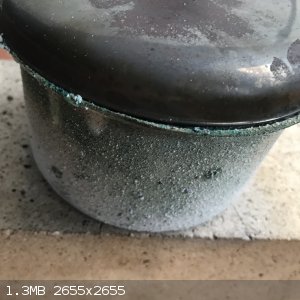 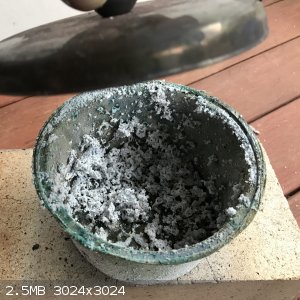
|
|
|
NeonPulse
Hazard to Others
  
Posts: 417
Registered: 29-6-2013
Location: The other end of the internet.
Member Is Offline
Mood: Isolated from Reality! For Real this time....
|
|
I have wondered if this method could work and there is a video that confirms my suspicion. This guy was able to make a decent looking amount of K
metal in a fairly simple setup which is possibly the easiest, highest yielding method i have seen so far: https://www.youtube.com/watch?v=Z1MVv0u2tmw
I have not given up obtaining K via the nurdrage method yet. it is going to work for me! but i want to attempt this one first though and have all the
needed reagents plus a steel setup from the cesium making runs.
|
|
|
phlogiston
International Hazard
    
Posts: 1379
Registered: 26-4-2008
Location: Neon Thorium Erbium Lanthanum Neodymium Sulphur
Member Is Offline
Mood: pyrophoric
|
|
I appreciate it ave369, your translation makes the video's content accessible to much larger audience.
Makes me wander how much really interesting stuff goes unnoticed to the much of the world because it is published in an uncommon language.
-----
"If a rocket goes up, who cares where it comes down, that's not my concern said Wernher von Braun" - Tom Lehrer |
|
|
NeonPulse
Hazard to Others
  
Posts: 417
Registered: 29-6-2013
Location: The other end of the internet.
Member Is Offline
Mood: Isolated from Reality! For Real this time....
|
|
Ok, so I made an attempt at distillation of Potassium from Calcium metal and potassium chloride. According to this reaction scheme: 2KCl + Ca —>
2K + CaCl2 I used my gas burner for a heat source. It did seem to go OK but very slowly due to not using a vacuum source. The potassium decider to
condense at the rim of the tube where the end of the retort went into the tube. This was bothersome so I waited till the lot cooled and collected what
had condensed. It was only a few beads but it was promising. I have quit a bit of Ca metal and loads of KCl so I plan to change the design of my
device a bit to avoid the problem of condensation at the rim. Using a vacuum would be ideal though but with a bit of tweaking I could probably
probably produce a nice amount of K in a small amount of time.
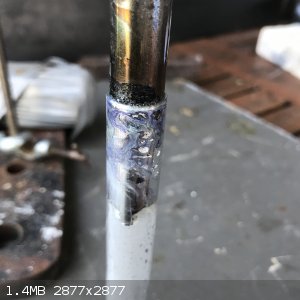
[Edited on 31-10-2017 by NeonPulse]
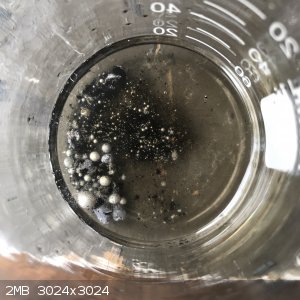
|
|
|
Bezaleel
Hazard to Others
  
Posts: 444
Registered: 28-2-2009
Member Is Offline
Mood: transitional
|
|
Quote: Originally posted by ave369  | I know Russian and can translate the video. The author of the video blocked adding translated subtitles to his video, but I'll write the transcript
here.
(...)
|
That's an interesting translation, ave369! Thanks for putting it here.
|
|
|
aga
Forum Drunkard
    
Posts: 7030
Registered: 25-3-2014
Member Is Offline
|
|
I had a go at the KOH + Mg thing today.
Definitely a more violent reaction than the Na version.
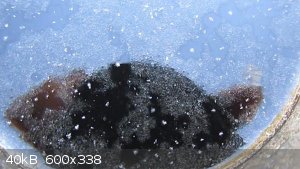
Some tiny (<1mm) blobs appeared. They explode when added to water 
Now to work on getting them out and coalesced.
Edit:
Petrol actually seems like a good idea, despite the boiling part.
Thanks for the translation ave !
[Edited on 6-12-2017 by aga]
|
|
|
NeonPulse
Hazard to Others
  
Posts: 417
Registered: 29-6-2013
Location: The other end of the internet.
Member Is Offline
Mood: Isolated from Reality! For Real this time....
|
|
Did another potassium experiment today. Similar to my last experiment I ran a distillation however today’s was run under vacuum. The results were
pretty good with nearly 3G of K metal once cleaned up. The synthesis was pretty straight forward with a 1/10th molar scale. The right amount of each
the KCl and Ca metal weee put into a steel retort with a long copper tube running into a receiver which was a test tube with a side arm from which the
vacuum was pulled. The problem was that once I pulled the vacuum some of the powdered KCl came over. This was pretty annoying but I continued on
anyway.
Shortly after starting the heating some potassium Began to come over and was pretty consistent through the process so long as the copper tube was kept
hot enough for the potassium to stay liquid. Not bad for a first attempt but there are some improvements for next time though including a larger
reaction vessel, using argon to flush the apparatus first and a thinner walled retort to lower the heat needed to keep it going. Also probably some
20mm test tubes instead of the 15mm ones I had here. Should have a video up soon.
Also I have had two different attempts at the NurdRage dioxane method for sodium but for potassium instead and it has not worked for me. The slag
from the reaction is incredibly reactive with the telltale lilac bursts of flame which indicates the metal is there but it just won’t coalesce like
the video depicted for NurdRage. It started looking promising though at first with tiny beads of metal floating around but it may have just been
consumed in the solvent somehow. Once the level got low in the reaction flask I just poured the distilled dioxane back to cycle it again. No joy
though. I’m going to try it for sodium and again for potassium before I declare it won’t work for me.
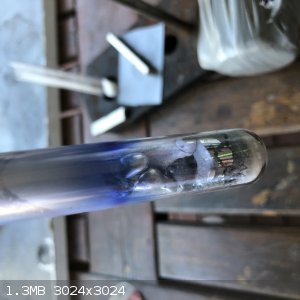 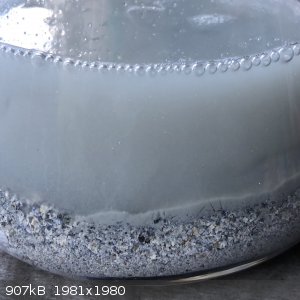
|
|
|
Iodobenzene
Harmless

Posts: 24
Registered: 27-12-2017
Location: In solution
Member Is Offline
Mood: Strongly Acidic
|
|
I found a procedure which uses 1,2,3,4 tetrahydronaftalene as the solvent and tert amyl alcohol as the catalyst.
What do you think about it?
|
|
|
MrHomeScientist
International Hazard
    
Posts: 1806
Registered: 24-10-2010
Location: Flerovium
Member Is Offline
Mood: No Mood
|
|
Post it. NurdRage used Tetralin in his synthesis, so I bought some and tried it but my hotplate failed on me. That stuff has a terrible odor that
slowly escapes from the bottles I used, which ruined my old lab fridge from storing it in there. If you buy it, be sure you have a very good bottle to
store it.
I can't remember who or what the result was but I'm sure someone here has tried tert amyl alcohol; it's buried somewhere in this thread.
|
|
|
Iodobenzene
Harmless

Posts: 24
Registered: 27-12-2017
Location: In solution
Member Is Offline
Mood: Strongly Acidic
|
|
The procedure is Italian and i found it on myttex.net ,it was written by an user named "Kirmer".
Here's the English translation i made:
Put 2,4 grams of Magnesium powder,5 grams of Potassium Hydroxide and 20 ml of 1,2,3,4 tetrahydronaftalene in an erlenmeyer flask.
Attach a 31 cm long liebig condenser to the erlenmeyer flask and close the condenser with aluminium foil.
Heat up to boil the mixture,when it gets clearer add 0,8 ml of tert amyl alcohol from the top of the condenser.
Slowly some globules of molten Potassium will start to form.
That's the reaction:
2Mg +2KOH ----> 2K + H2 +2 MgO
The alcohol is the catalyzer.
Add 0,1 ml every 10 minutes of tert amyl alcohol and in 2/3 hours a ball of Potassium will form.
Turn off the heating,and pour the mixture in a beaker filled with vaseline and separate the potassium balls.
Store the potassium balls in a glass container filled with vaseline.
Here some pics:
http://www.myttex.net/forum/attachment.php?aid=5421
http://www.myttex.net/forum/attachment.php?aid=5422
Here the link to the original in italian:
http://www.myttex.net/forum/Thread-Come-fare-il-Potassio
|
|
|
Iodobenzene
Harmless

Posts: 24
Registered: 27-12-2017
Location: In solution
Member Is Offline
Mood: Strongly Acidic
|
|
What do you think about it?
Can i sobstitute 1,2,3,4 tetrahydronaftalene with a commoner solvent?
|
|
|
MrHomeScientist
International Hazard
    
Posts: 1806
Registered: 24-10-2010
Location: Flerovium
Member Is Offline
Mood: No Mood
|
|
Sorry to say it, but read the thread. There's an enormous amount of discussion on every single aspect of this reaction.
The general consensus is that the solvent must not react with the reactants or products and that it has a high boiling point (over 200C if I remember
right). Which catalysts will work and which won't is a bit more of a mystery. There were also experiments using Mg powder vs Mg turnings that had
mixed success either way. I used lamp oil and tert-butyl alcohol when I did it.
The one you posted looks like a pretty standard method, using the "staggered addition" strategy for the catalyst. Some may disagree, but we found that
this isn't necessary; you can add the catalyst all at the beginning and the synthesis still works. That's what I did in mine, anyway.
The tetralin is used as a solvent because potassium floats in it, which greatly improves metal coalescence. With my lamp oil, much of the K remained
as sand (tiny beads) that refused to combine into larger spheres. Tetralin, unfortunately, appears to be one of the very few solvents that K will
float in but not react with.
|
|
|
experimenter_
Harmless

Posts: 38
Registered: 18-2-2016
Member Is Offline
Mood: No Mood
|
|
tert-butanol from chlorobutanol
Chlorobutanol is easier to make than tert-butanol (chloroform and acetone react much more easily to make chlorobutanol compared to a Gignard reaction
required for tert-butanol synthesis). The question is, can chlorobutanol be reduced to tert-butanol by hydrogenation? A relevant thread here doesn't
reveal much:
https://www.sciencemadness.org/whisper/viewthread.php?tid=71...
The simplest possible routes I could find are the Zn/HCl reduction or the addition of Mg in an ethanolic (?) solution of chlorobutanol. Reference: http://staff.um.edu.mt/ratk1/HaloAlkaneProps.htm
I'm sure you might have more ideas.
Do you think it is possible for the amateur?
Discussion could be continued here: https://www.sciencemadness.org/whisper/viewthread.php?tid=71...
|
|
|
S.C. Wack
bibliomaster
    
Posts: 2419
Registered: 7-5-2004
Location: Cornworld, Central USA
Member Is Offline
Mood: Enhanced
|
|
It would be a worthwhile investigation for the serious experimenter. I'd try this if I didn't already have plenty. Magnesium forms the alkoxide with
primary alcohols under the conditions of OS CV5, 998 - AV47, 103 (where the Mg is powder BTW) thus ethanol is out.
|
|
|
JScott
Hazard to Self
 
Posts: 51
Registered: 23-8-2018
Member Is Offline
|
|
Partial Success
I followed the video Neon Pulse put on YouTube. Thank you for that inspiration!
I was somewhat concerned that my Mg wasn't fine enough at 250 mesh it certainly wasn't 'dust'. Also, that sample arrived here nearly two years ago
(though the bottle hasn't been opened since then, and it was packed hard to the top). With it's age meaning more heavily oxidized Mg, my expectations
were that I was endeavoring to learn. I did not have any expectations of success as I was under the impression this was an advanced procedure anyhow
so wasn't too concerned about this first effort's results.
I take photos of most setups, I don't draw well and was taught to always include a drawing of my apparatuses in my notes. I also take photos of
completion (the product) even if I don't feel I've gotten anywhere. You need a starting point before you can go anywhere.
It took a while to get my temperature up, a thermocouple in the sand was only indicator. I didn't have a thermometer at the head of the still or in
the flask. In the end the temperature at the bottom of the flask, in the sand was 351C. The contents of the flask boiled well through the entire
procedure.
I have included those two "failure photos" more as proof of having been there. I don't see, and didn't see then any potassium. It is now clear to me
that more time and perhaps low temperatures for coalescing might have yielded something more obvious.
It wasn't until clean up (and yes I did consider what might happen if there was potassium in the flask) that I noticed anything interesting. In the
interest of the getting flask clean I started by adding about 10ml of water. I was very pleasantly surprised to see an obvious, colorful K fire with
some Mg thrown in for good measure!
Any advise would be greatly appreciated. Reading the posts to this point (something I suppose I should have done BEFORE doing this ;-)) has been very
helpful and given me a number of places to improve my procedure.
In the end I would think the larger Mg particle size was my main issue. Would a longer reflux make up for the larger particles?
Thanks in advance for your kind considerations. Just two photos, the reflux and the flask after 4:30 in the procedure (I called it complete at this
point, though had I come here and read this posting I would have gone for much longer).
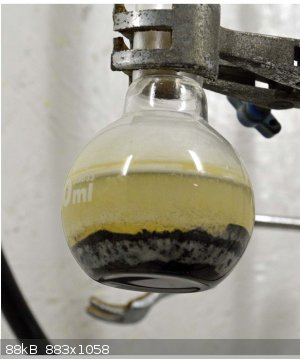 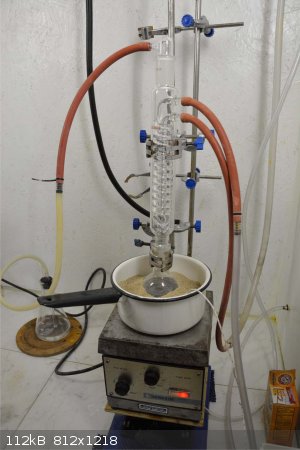
|
|
|
UC235
National Hazard
   
Posts: 565
Registered: 28-12-2014
Member Is Offline
Mood: No Mood
|
|
Double check your solvent!
I had a go at the Mg/oil reduction yesterday using Mineral Oil Laxative from Walmart (Their house Equate brand). After 3 1/2 hours I wasn't seeing
anything. The dehydration phase seemed to have gone well, and it was gently simmering with the sand bath at 215-225C.
I made the dumb assumption that the gently simmering solvent was the same temperature as the sand bath, which isn't outrageous considering the flask
was buried up to the solvent line in sand. I shut things down and before it cooled off, stuck the thermometer in the mineral oil. It was only 160C
somehow. Well, no wonder nothing happened. I either need a different source of mineral oil or I need to distill this stuff until I get to ~220C and
use what's left in the pot.
|
|
|
elementcollector1
International Hazard
    
Posts: 2684
Registered: 28-12-2011
Location: The Known Universe
Member Is Offline
Mood: Molten
|
|
My initial tests with mineral oil failed as well - when I switched to kerosene lamp oil, things started improving almost immediately. I also had a
problem with getting to 200 C with my hot plate (back then, a Hamilton Beach cooking plate). My advice is simply to change your solvent and upgrade
your heating source. Also, invest in stirring if you can - it worked wonders on my final runs, improved the yield quite a bit.
Elements Collected:52/87
Latest Acquired: Cl
Next in Line: Nd
|
|
|
j_sum1
|
Thread Split
14-10-2018 at 00:08 |
| Pages:
1
..
62
63
64
65
66 |